Overview
- Brief Narrative
- Ebro candy tin used by Rachel “Chelly” de Groot from November 1942 to April 1944 and recovered by her brother Louis after the war. Chelly used the box to store small red glass beads that she used to make handicrafts. Nazi Germany invaded the Netherlands on May 10, 1940, and implemented anti-Jewish restrictions. In July 1942, the Germans began mass deportations. On November 16, 1942, Chelly, 15, Louis, 13, and their parents Meijer and Sophia left Arnhem and went into hiding after the Dutch police warned them of a raid. Meijer and Sophia hid in Amsterdam while Chelly and Louis moved around to different locations. In summer or fall 1943, Chelly went to Amsterdam to live with her parents. In December, Louis was sent to Lemmer to live with the Onderweegs family. In February 1944, Dirk Onderweegs visited and offered to take Chelly to a safer hiding place. On April 8, 1944, four days before Dirk was to return, Chelly and her parents were denounced and arrested. They were sent to Westerbork transit camp, then to Auschwitz. Chelly and Sophia were killed upon arrival in Auschwitz on May 22, 1944. Meijer was selected for a work detail and was killed on September 30, 1944. Louis remained in hiding with Onderweegs until liberation in mid-April 1945.
- Date
-
use:
after 1942 November-before 1944 April
recovered: approximately 1946 August-1950
- Geography
-
use:
Netherlands
- Credit Line
- United States Holocaust Memorial Museum Collection, Gift of Louis de Groot
- Markings
- a. top, center, yellow and black paint : EBRO / ZOUTE GRIOTTEN [Salty licorice cubes]
b. bottom, stamped : EBRO - Contributor
-
Subject:
Rachel de Groot
Subject: Louis de Groot
Manufacturer: Ebro
- Biography
-
Rachel (Chelly) de Groot was born on August 8, 1927, in Amersfoort, Netherlands, to Meijer and Sophia Swaab de Groot. Chelly had a brother, Levie (Louis), born on June 28, 1929. Chelly’s father Meijer was born on October 9, 1897, in Utrecht, to Rachel Bloemendaal de Groot. Meijer had five siblings. Chelly’s mother Sophia was born on June 10, 1900, in Utrecht, to Meijer (1877-1934) and Heintje van Leeuwen (1878-1935) Swaab. Sophia had six siblings. In 1932, the family moved to Arnhem. Meijer owned a hardware and electrical appliance store. The family was comfortable but not wealthy. They attended synagogue weekly and observed every holiday. Chelly and Louis were members of a local Jewish youth organization. Meijer and Sophia were involved with the Jewish Refugee Committee and assisted Jews fleeing from Germany. After the Kristallnacht pogrom occurred in Germany and Austria in November 1938, they took in an Austrian Jewish Kindertransport refugee, Eva Haller.
On May 10, 1940, Germany invaded the Netherlands. Meijer found a taxi driver who was willing to take them to a port city in the west so they could go to England. They could not get out because the Dutch army had flooded the roads. The Netherlands surrendered on May 14. The German authorities gradually implemented anti-Semitic measures. Jews were no longer allowed to swim in public pools or go to the parks. They were only allowed to shop between 3 and 5 PM. In late 1940, Chelly’s paternal uncle Israel was arrested and jailed on suspicion of working with the resistance. He had a trial and was released in February 1941. Mass deportations began in July 1942. On November 16, 1942, Dutch police warned Chelly’s family that a raid was planned for that night. Chelly and Louis stayed the night with one of Meijer’s employees, Herman Lagenbach. Meijer and Sophia arranged to hide with a neighbor, but he refused to let them in the next day. They went to Hilversum, where Chelly’s paternal uncle Israel was in hiding. He had contacts in the resistance and helped them find hiding places. Chelly went to a home in Hilversum. Meijer and Sophia eventually moved to Chelly to other hiding places. In 1943, Chelly was moved to Wormerveer. She stayed with the mother of the woman who was hiding Louis, Lies Stolp. After Louis left Lies’ home, Lies wanted to take Chelly so she could get paid more. Chelly’s parents found out and refused because Lies had mistreated Louis. They brought Chelly back to Amsterdam to stay with them. In December, Louis was sent to the Friesland province. Chelly remained in Amsterdam in with her parents.
In February 1944, Sophia, Meijer, and Chelly were visited by Dirk Onderweegs, the resistance member who was hiding Louis. He was active in the resistance and offered to find a hiding place for Chelly closer to Louis. Sophia and Meijer agreed and arranged for Dirk to pick up Chelly after Easter. On April 8, Sophia, Meijer, and Chelly were denounced by Ans van Dijk, a Jewish woman who worked for the Gestapo. She thought she was turning in Meijer’s brother Izak. Jaap Grotendorst, the Dutch policeman who came for them, was a childhood friend of Meijer’s and recognized him immediately. Jaap refused a bribe and arrested them. Chelly and Sophia were held in the Amsterdam police station, then sent to jail in The Hague. After about a week, they were reunited with Meijer and sent to Westerbork transit camp. On May 19, they were loaded into wagon 9 of a transport and sent to Auschwitz. When they arrived at Auschwitz on May 22, Sophia and Chelly were separated. Chelly cried so fiercely that a SS officer allowed her to switch places with another woman. Sophia and Chelly were sent to the gas chamber and killed. Chelly’s father Meijer was selected for a work detail and was killed on September 30, 1944. Her brother Louis survived the Holocaust in hiding.
Levie (Louis) de Groot was born on June 28, 1929, in Amersfoort, Netherlands, to Meijer and Sophia Swaab de Groot. Louis had a sister, Rachel (Chelly), born on August 8, 1927, in Amersfoort. Louis’ father Meijer was born on October 9, 1897, in Utrecht, to Rachel Bloemendaal de Groot. Meijer had five siblings. Louis’ mother Sophia was born on June 10, 1900, in Utrecht, to Meijer (1877-1934) and Heintje van Leeuwen (1878-1935) Swaab. Sophia had six siblings. In 1932, the family moved to Arnhem. Meijer owned a hardware and electrical appliance store. They attended synagogue weekly and observed the holidays. Louis and Chelly were involved with a local Jewish youth organization. Louis attended public school until 1939, when he had an anti-Semitic teacher. His parents pulled him from school and sent him to a Montessori school. Meijer and Sophia were involved with the Jewish Refugee Committee and assisted Jews fleeing from Germany. After the Kristallnacht pogrom occurred in Germany and Austria in November 1938, they took in an Austrian Jewish Kindertransport refugee, Eva Haller.
On May 10, 1940, Germany invaded the Netherlands. Meijer found a taxi driver who was willing to take them to a port city in the west so they could go to England. They could not get out because the Dutch army had flooded the roads. The Netherlands surrendered on May 14. The German authorities gradually implemented anti-Semitic measures. Jews were no longer allowed to swim in public pools or go to the parks. They were only allowed to shop between 3 and 5 PM. Louis was taunted by two boys who were in the Nazi Youth group and began to beat them up daily with his friends. One of the boy’s father was a Nazi and told Louis’ father that he would be sent to a concentration camp if Louis did not stop. Louis became too afraid to violate any regulations, in case his family was punished. In late 1940, Louis’ paternal uncle Israel was arrested and jailed on suspicion of working with the resistance. He had a trial and was released in February 1941. In September 1941, Louis had to attend a new school because Jewish children were banned from public schools. He was also forbidden from visiting the homes of non-Jews. Beginning on May 1, 1942, Jews were required to wear Star of David badges. In July, mass deportations began. In August, one of Louis’ friends told him that he had listened to a BBC broadcast on the radio, which said that Jews were being sent to the east and killed. Louis did not want believe it was true and did not tell his family about it.
On November 16, 1942, Dutch police warned Louis’ family that a raid was planned for that night. Louis and Chelly stayed the night with one of Meijer’s employees, Herman Lagenbach. Meijer had arranged to hide with a neighbor, but he refused to let them in the next day. They went to Hilversum, where Louis’ paternal uncle Israel was in hiding. He had contacts in the resistance and arranged hiding places for them. Chelly went to a home in Hilversum, while Louis and his parents continued to Amsterdam. Louis was sent to a couple in Den Helder. In December, Louis was reported to the Dutch police by the neighbors, who heard him talking through the thin walls. The Dutch police came to arrest Louis, but told him they would help him. They brought him back to Amsterdam so he could find his parents. They were hiding with Geertruida (Truus) Eweg, who didn’t want Louis to stay. On January 1, 1943, Louis went to Wormerveer to stay with Cees and Lies Stolp. Cees and Lies mistreated Louis. He was given very little food and was not allowed to bathe often or wash his clothes. He had to make envelopes for the family to sell and was required to meet a daily quota. They dictated his letters to his parents so he could not tell them what was happening. Louis’ maternal cousin Heni Cohen, the daughter of Sophia’s sister Leentje, eventually came to live with them. Lies went to see Louis’ parents monthly to collect rent and ration cards for the children. After a disagreement between Louis and Lies, Louis’ father Meijer insisted on visiting in the early summer. He took Louis back to Amsterdam and was upset when Louis told him what happened. Louis moved between about twelve hiding places and stayed with his parents in Amsterdam in between. At the end of September 1943, Louis was reunited with his parents and sister. After about six weeks, all four had to go on the run. Louis stayed with Meijer and Chelly with Sophia. They returned to Amsterdam in December.
Meijer arranged for Louis to go to Friesland, a province in northeastern Netherlands that had a large population of Calvinists. On December 22, Frans Postma, a detective with the Amsterdam police force, took Louis to Joure to stay with Uilke Boonstra (1899-1944). Uilke ran the resistance organization in southwestern Friesland with Sjoerd Weirsma. On January 3, 1944, Louis was moved to the home of Dirk (1908-1979) and Ann (1910-1993) Onderweegs and their young daughter Bonnette (1940-1986) in Lemmer. Dirk was supposed to find a different hiding place for Louis, but Ann insisted that he stay so he would not have to labor on a farm. The couple also hid a Jewish baby, Robert Wolf. Dirk worked in City Hall and used his position to forge false documents for hidden Jews and to falsify records to match. He forged documents for Louis, one saying he was a refugee from bombing and another saying his circumcision was performed for medical reasons. They dyed Louis’ hair red so he would look less Jewish. In February 1944, Uilke Boonstra was arrested and sent to Vught concentration camp. Dirk took over his responsibilities in the resistance. On a trip west in February, Dirk met Louis’ parents and promised that he would find a better hiding place for Chelly in Friesland. Dirk returned to get Chelly on April 12, but was stopped by their neighbor and told that Meijer, Sophia, and Chelly were arrested on April 8. Dirk used his contacts to learn that the family was in Westerbork transit camp. He went to Westerbork to bribe the guards and get them out, but was unsuccessful. In late June 1944, Dirk and Ann were turned into the Gestapo for their role in the resistance. They were warned by the telephone operator and went on the run. They assumed the false last name Lemstra. Louis was called Leo and Dirk was called Paul. Louis and Bonnette went to a farm in the area, while Dirk, Ann, and Robert stayed together, until they reunited in Bolsward. Louis worked with Dirk for the resistance. He forged documents, worked as a courier, and stole rubber stamps from the Germans. In February 1945, the Gestapo found them again, but they were warned beforehand and fled. Louis was liberated by Canadian forces in Bolsward in mid-April 1945.
Louis and the Onderweegs family returned to Lemmer. Robert’s mother survived the war and took him back. Louis enrolled in school when it reopened. In August 1946, Louis left the Onderweegs family so he could return to a Jewish environment. He lived in a Jewish orphanage in Amsterdam. He was in contact with his uncle Israel. In 1947, Louis learned what happened to his family. Louis’ mother and sister were killed upon arrival in Auschwitz on May 22, 1944. Louis’ father was selected for a work detail and was killed on September 30, 1944. Most of Louis’ extended family was also killed. Eva Haller, the Kindertransport refugee who lived with the family, survived the Holocaust in hiding in the Netherlands. From April 1948 to February 1949, Louis fought with the Haganah in Palestine. He returned to the Netherlands to finish school, then emigrated to the United States in 1950. He was drafted into the US Army and served in Germany in the Army of Occupation for two years. Louis attended Columbia University and received a degree in Economics in 1956. On June 7, 1956, Louis married Barbara Brenner (1935-2015). In 1958, Louis received his master’s degree from New York University. Louis and Barbara had two sons. Louis worked for IBM until he retired. Louis’s son Marc, age 45, died on August 8, 2004.
Physical Details
- Language
- Dutch
- Classification
-
Containers
- Category
-
Metal containers
- Object Type
-
Advertising tins (lcsh)
- Physical Description
- a. Small, circular, tin container lid with a rounded edge, painted gold on the exterior and silver on the interior. On the top center is a painted yellow circle with a portrait of a man with short hair, round glasses, and a serious expression. Twelve long black cones border the circle, with yellow text in the upper triangles and a yellow banner with black text over the lower triangles.
b. Small, circular, tin container base, with an indented rim to support the lid and a recessed bottom. The tin was used to store red glass beads (2003.155.5).
c-d 2 needles found in tin container - Dimensions
- a: Depth: 0.500 inches (1.27 cm) | Diameter: 2.500 inches (6.35 cm)
b: Depth: 0.375 inches (0.953 cm) | Diameter: 2.375 inches (6.032 cm) - Materials
- a : metal, paint
b : metal, paint
Rights & Restrictions
- Conditions on Access
- No restrictions on access
- Conditions on Use
- No restrictions on use
Keywords & Subjects
- Topical Term
- Deportees--Netherlands--Amsterdam--Biography. Hidden children (Holocaust)--Netherlands--Biography. Holocaust, Jewish (1939-1945)--Netherlands--Personal narratives. Holocaust victims--Netherlands--Biography. Jewish children in the Holocaust--Netherlands--Biography. Jews--Persecution--Netherlands--Biography. World War, 1939-1945--Underground movements--Netherlands--Personal narratives, Jewish.
Administrative Notes
- Legal Status
- Permanent Collection
- Provenance
- The container was donated to the United States Holocaust Memorial Museum in 2003 by Louis de Groot, the brother of Rachel de Groot.
- Funding Note
- The cataloging of this artifact has been supported by a grant from the Conference on Jewish Material Claims Against Germany.
- Record last modified:
- 2024-06-17 10:43:17
- This page:
- https://collections.ushmm.org/search/catalog/irn513934
Download & Licensing
In-Person Research
- By Appointment
- Request 21 Days in Advance of Visit
- Plan a Research Visit
- Request to See This Object
Contact Us
Also in Louis de Groot family collection
The collection consists of beads, beadwork, two containers, a calendar, and an autograph book relating to the experiences of Rachel de Groot and her brother Louis de Groot during the Holocaust while in hiding in the Netherlands, and a wall hanging relating to the experiences of their mother, Sophia de Groot, before the Holocaust in Arnhem. The collection also includes original and copyprint photographs related to the wartime experiences of Louis de Groot. Includes photos of a child who was in hiding with de Groot. Some of these materials may be combined into a single collection in the future.
Date: 1938-1945
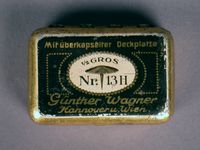
Tin box used to store beads by a Dutch Jewish girl in hiding
Object
Günther Wagner tack box used by Rachel “Chelly” de Groot from November 1942 to April 1944 and recovered by her brother Louis after the war. Chelly used the box to store unfinished red glass beadwork and small glass beads that she used to make handicrafts. Nazi Germany invaded the Netherlands on May 10, 1940, and implemented anti-Jewish restrictions. In July 1942, the Germans began mass deportations. On November 16, 1942, Chelly, 15, Louis, 13, and their parents Meijer and Sophia left Arnhem and went into hiding after the Dutch police warned them of a raid. Meijer and Sophia hid in Amsterdam while Chelly and Louis moved around to different locations. In summer or fall 1943, Chelly went to Amsterdam to live with her parents. In December, Louis was sent to Lemmer to live with the Onderweegs family. In February 1944, Dirk Onderweegs visited and offered to take Chelly to a safer hiding place. On April 8, 1944, four days before Dirk was to return, Chelly and her parents were denounced and arrested. They were sent to Westerbork transit camp, then to Auschwitz. Chelly and Sophia were killed upon arrival in Auschwitz on May 22, 1944. Meijer was selected for a work detail and was killed on September 30, 1944. Louis remained in hiding with Onderweegs until liberation in mid-April 1945.
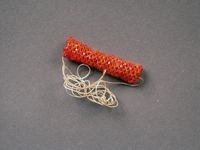
Unfinished red glass beadwork made by a Dutch Jewish girl in hiding
Object
Unfinished length of red glass beadwork made by Rachel “Chelly” de Groot from November 1942 to April 1944 and recovered by her brother Louis after the war. The beadwork may have been for a bracelet. Nazi Germany invaded the Netherlands on May 10, 1940, and implemented anti-Jewish restrictions. In July 1942, the Germans began mass deportations. On November 16, 1942, Chelly, 15, Louis, 13, and their parents Meijer and Sophia left Arnhem and went into hiding after the Dutch police warned them of a raid. Meijer and Sophia hid in Amsterdam while Chelly and Louis moved around to different locations. In summer or fall 1943, Chelly went to Amsterdam to live with her parents. In December, Louis was sent to Lemmer to live with the Onderweegs family. In February 1944, Dirk Onderweegs visited and offered to take Chelly to a safer hiding place. On April 8, 1944, four days before Dirk was to return, Chelly and her parents were denounced and arrested. They were sent to Westerbork transit camp, then to Auschwitz. Chelly and Sophia were killed upon arrival in Auschwitz on May 22, 1944. Meijer was selected for a work detail and was killed on September 30, 1944. Louis remained in hiding with Onderweegs until liberation in mid-April 1945.
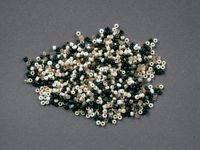
Small black, white, gold, and clear glass beads used by a Dutch Jewish girl in hiding
Object
Several tiny black, white, gold, and clear glass beads used by Rachel “Chelly” de Groot from November 1942 to April 1944 and recovered by her brother Louis after the war. Chelly used the beads to make handicrafts. Nazi Germany invaded the Netherlands on May 10, 1940, and implemented anti-Jewish restrictions. In July 1942, the Germans began mass deportations. On November 16, 1942, Chelly, 15, Louis, 13, and their parents Meijer and Sophia left Arnhem and went into hiding after the Dutch police warned them of a raid. Meijer and Sophia hid in Amsterdam while Chelly and Louis moved around to different locations. In summer or fall 1943, Chelly went to Amsterdam to live with her parents. In December, Louis was sent to Lemmer to live with the Onderweegs family. In February 1944, Dirk Onderweegs visited and offered to take Chelly to a safer hiding place. On April 8, 1944, four days before Dirk was to return, Chelly and her parents were denounced and arrested. They were sent to Westerbork transit camp, then to Auschwitz. Chelly and Sophia were killed upon arrival in Auschwitz on May 22, 1944. Meijer was selected for a work detail and was killed on September 30, 1944. Louis remained in hiding with Onderweegs until liberation in mid-April 1945.
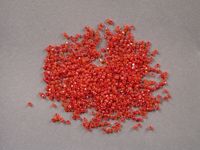
Small red glass beads used by a Dutch Jewish girl in hiding
Object
Small red glass beads used by Rachel “Chelly” de Groot from November 1942 to April 1944 and recovered by her brother Louis after the war. Chelly used the beads to make handicrafts. Nazi Germany invaded the Netherlands on May 10, 1940, and implemented anti-Jewish Semitic restrictions. The Germans began mass deportations in July 1942. On November 16, 1942, Chelly, 15, Louis, 13, and their parents Meijer and Sophia left Arnhem and went into hiding after the Dutch police warned them of a raid. Meijer and Sophia hid in Amsterdam while Chelly and Louis moved around to different locations. In summer or fall 1943, Chelly went to Amsterdam to live with her parents. In December, Louis was sent to Lemmer to live with the Onderweegs family. In February 1944, Dirk Onderweegs visited and offered to take Chelly to a safer hiding place. On April 8, 1944, four days before Dirk was to return for Chelly, Chelly and her parents were denounced and arrested. They were sent to Westerbork transit camp, then to Auschwitz. Chelly and Sophia were killed upon arrival in Auschwitz on May 22, 1944. Meijer was selected for a work detail and was killed on September 30, 1944. Louis survived the Holocaust in hiding with the Onderweegs family.
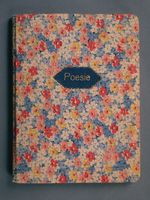
de Groot family autograph album
Document
Hand covered autograph and poetry notebook used by Rachel (Chelly) de Groot while in hiding in the Netherlands. It was recovered by her brother Louis after the war.
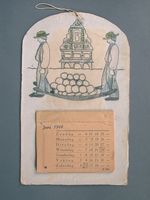
Handmade 1944 calendar made by a hidden Dutch Jewish girl for her brother
Object
Handmade calendar made by 16 year old Rachel “Chelly” de Groot for her 14 year old brother Louis while they were in hiding in separate places in the Netherlands in 1944. Chelly copied an image of the Alkmaar Cheese Market, depicting two men carrying cheese in front of the Alkmaar Weigh House. Louis received the calendar after Dirk Onderweegs, the resistance member Louis was staying with, visited his family in February 1944. The calendar displays June 1944 because Louis and the Onderweegs had to flee their home in June, after they were turned into the Gestapo for their resistance activity. Germany occupied the Netherlands in May 1940 and implemented anti-Jewish restrictions. In July 1942, the Germans began mass deportations. On November 16, 1942, Chelly, 15, Louis, 13, and their parents Meijer and Sophia left Arnhem and went into hiding. Meijer and Sophia hid in Amsterdam while Chelly and Louis moved around to different locations. In summer/fall 1943, Chelly went to Amsterdam to live with her parents. In December, Louis was sent to Lemmer to live with the Onderweegs family. In February 1944, Dirk Onderweegs visited and offered to take Chelly to a safer hiding place. On April 8, 1944, four days before Dirk was to return, Chelly and her parents were denounced and arrested. They were sent to Westerbork transit camp, then to Auschwitz. Chelly and Sophia were killed upon arrival in Auschwitz on May 22, 1944. Meijer was selected for a work detail and was killed on September 30, 1944. Louis remained in hiding with Onderweegs until liberation in mid-April 1945.
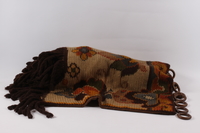
Hand knitted floral wall hanging made prewar by a Dutch Jewish woman
Object
Floral patterned, fringed wall hanging created by Sophia Swaab de Groot in 1938 or 1939 in Arnhem, Netherlands, and recovered by her son Louis after the war. Sophia made the wall hanging to protect the wall behind the living room couch. She worked on it for hours over several nights and used a paper pattern to create it. Germany occupied the Netherlands in May 1940 and implemented anti-Jewish restrictions. In July 1942, the Germans began mass deportations. On November 16, 1942, Chelly, 15, Louis, 13, and their parents Meijer and Sophia left Arnhem and went into hiding. Meijer and Sophia hid in Amsterdam while Chelly and Louis moved around to different locations. In summer/fall 1943, Chelly went to Amsterdam to live with her parents. In December, Louis was sent to Lemmer to live with the Onderweegs family. In February 1944, Dirk Onderweegs visited and offered to take Chelly to a safer hiding place. On April 8, 1944, four days before Dirk was to return, Chelly and her parents were denounced and arrested. They were sent to Westerbork transit camp, then to Auschwitz where Chelly and Sophia were killed upon arrival on May 22, 1944. Meijer was selected for a work detail and was killed on September 30, 1944. Louis remained in hiding with Onderweegs until liberation in mid-April 1945.



